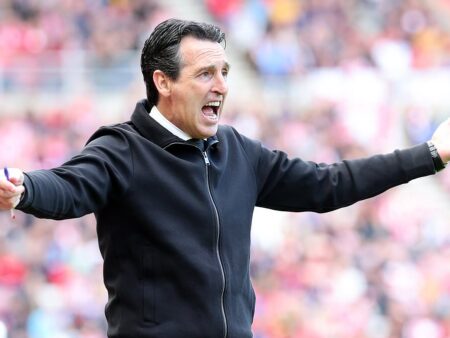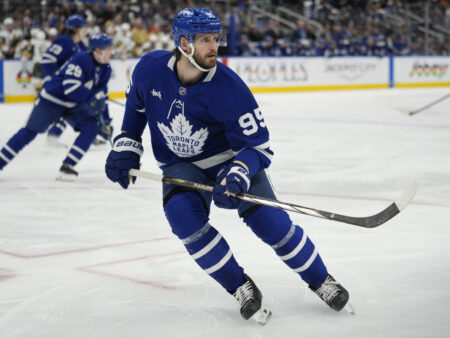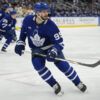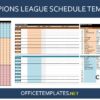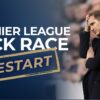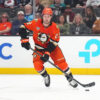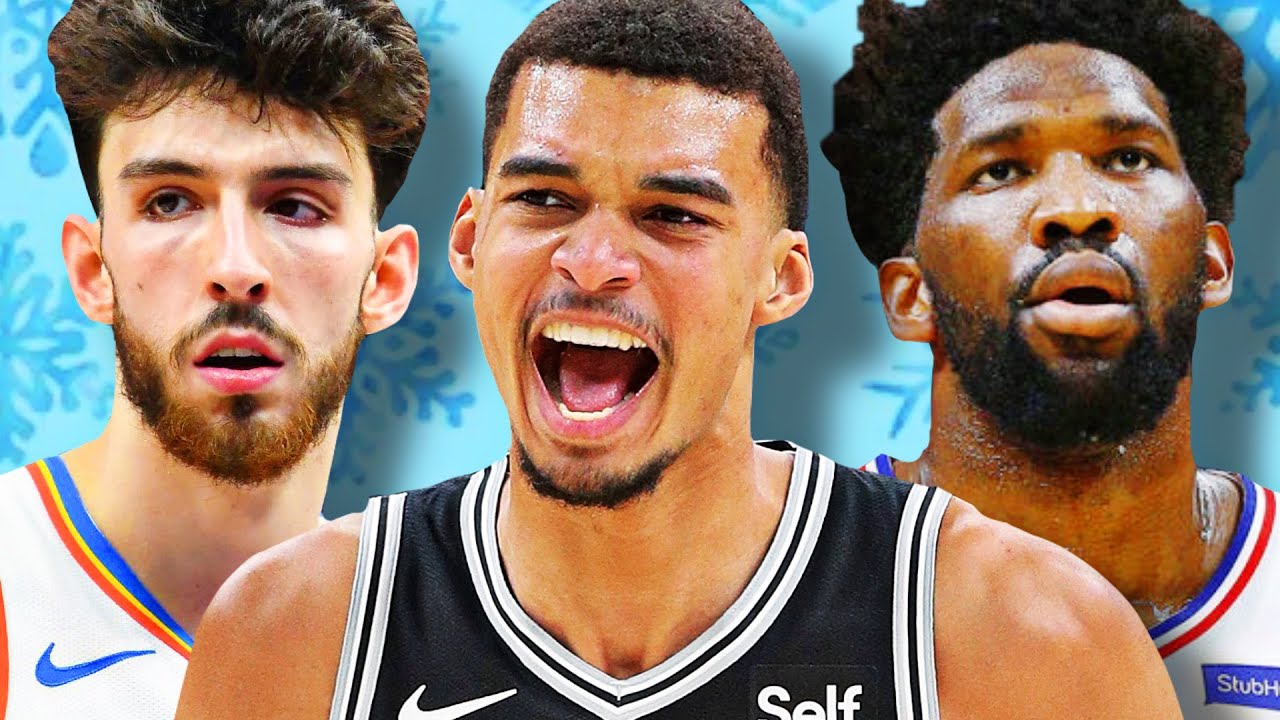
Despite the NBA offseason, preparations for the 2025-26 season are gaining momentum. As the new national TV schedule takes shape and the season schedule is unveiled, it`s time to assess the standing of all 30 teams. Below, we identify a crucial number that encapsulates each team`s position as the 2025-26 season approaches, along with key factors that could influence their performance over the next 10 months.
 Atlanta Hawks: 10 and 5
Atlanta Hawks: 10 and 5
Entering the new season, the Atlanta Hawks have reasons for optimism, including Dyson Daniels` potential breakout and a successful offseason. However, the team`s chances of repeating their 2021 conference finals run might hinge on the continued development of Jalen Johnson. Despite playing only 36 games last season due to injuries, the forward was highly productive when available. Johnson averaged 10 rebounds and 5 assists per game, joining an elite group of players—Nikola Jokic, Giannis Antetokounmpo, Domantas Sabonis, and Joel Embiid (over the past four seasons)—who have reached similar round numbers. While this doesn`t imply MVP contention, it suggests Johnson could be closer to All-NBA recognition and true stardom than widely perceived.
 Boston Celtics: 99.5%
Boston Celtics: 99.5%
The most significant absence for the Celtics this season will undoubtedly be Jayson Tatum, as the six-time All-Star recovers from an Achilles tear. Yet, the drastic change in Boston`s big man rotation should not be underestimated. Last postseason, the Celtics allocated 99.5% of their center minutes (excluding garbage time) to Al Horford, Kristaps Porzingis, and Luke Kornet. All three are now gone. They will be replaced by a combination of Neemias Queta, Luka Garza, Chris Boucher, and Xavier Tillman. While these players offer diverse strengths and play styles, they are generally considered less impactful than their predecessors. This represents a major adjustment for Boston and coach Joe Mazzulla, further raising doubts about the Celtics` competitiveness during their Tatum-less transitional year.
 Brooklyn Nets: 3
Brooklyn Nets: 3
Last season, six Nets players averaged at least three minutes of possession per game, according to GeniusIQ tracking data. Five of these six—Dennis Schroder, D`Angelo Russell, Ben Simmons, Killian Hayes, and Trendon Watford—are no longer with the team, nor is Cameron Johnson, who was second in team scoring. New acquisition Michael Porter Jr. should help with shot-making, but he`s not a primary ball-handler. This opens up significant ball-handling opportunities for Brooklyn`s young backcourt. Expect considerable growing pains from the Nets, who drafted a record five first-rounders. Additionally, if Cam Thomas re-signs as a restricted free agent, he is likely to post a remarkably high usage rate, following his 32.6% mark last season (just behind Paolo Banchero and Cade Cunningham).
 Charlotte Hornets: 35.9%
Charlotte Hornets: 35.9%
LaMelo Ball led the league with a 35.9% usage rate last season, the 23rd-highest single-season mark ever. Typically, players with such heavy workloads are superstars delivering big numbers; 19 of the 22 players with higher usage rates made an All-NBA team in that respective season. However, even if Ball had played enough games to qualify for All-NBA consideration, he wouldn`t have come close. His Player Efficiency Rating (PER) was the worst for any player with a 35% usage rate in NBA history. Coupled with his frequent injury absences, it remains uncertain whether Ball is still a franchise cornerstone around whom the Hornets should build, or merely a ball-dominant entertainer who doesn`t consistently contribute to winning.
 Chicago Bulls: 164
Chicago Bulls: 164
The Chicago Bulls have embodied NBA mediocrity for years, and their record proves it. Over the past four seasons, since they began a new era with the additions of DeMar DeRozan, Lonzo Ball, and Alex Caruso, the Bulls have posted an exact .500 record: 164 wins and 164 losses. While DeRozan, Ball, Caruso, and Zach LaVine are all off the roster, the team shows no signs of committing to a true rebuild, having sought players instead of draft picks in trades for Ball and Caruso. This approach suggests they are poised to once again hover around .500 in the 2025-26 season.
 Cleveland Cavaliers: 42%
Cleveland Cavaliers: 42%
In three seasons with Donovan Mitchell, the Cavaliers hold a 163-83 regular-season record (66% win rate), ranking third-best in the NBA during that period. However, in the playoffs, their performance has dropped significantly, with a record of just 11-15 (42%). While injuries to Mitchell, Darius Garland, Evan Mobley, and Jarrett Allen have played a role, Cleveland has consistently fallen short in their playoff defeats, losing in five games in each of the past three seasons. Following a dominant 64-18 showing last season, expect more regular-season success from Cleveland in 2025-26. Yet, the Cavaliers have reached a similar juncture to the Milwaukee Bucks at the start of the decade: impressive regular-season play means little if they cannot prove themselves in the playoffs.
 Dallas Mavericks: 5
Dallas Mavericks: 5
For the Mavericks to capitalize on their competitive window before Kyrie Irving (33) and Anthony Davis (32) enter their mid-thirties, Irving`s recovery from left ACL surgery this season is paramount. Only slightly less crucial is the immediate high-impact contribution expected from No. 1 pick Cooper Flagg, who will be 18 on opening night. Flagg is widely regarded as one of the best NBA prospects in decades, certainly possessing immense potential. However, it`s a formidable challenge for any player of his age and experience to immediately contribute to winning basketball, regardless of talent. Historically, only five teenagers—Jayson Tatum, Luol Deng, Carmelo Anthony, Tony Parker, and Stephon Marbury—have been regular perimeter starters for a playoff team. Tatum is the only one to achieve this in the past two decades.
 Denver Nuggets: 7
Denver Nuggets: 7
Basketball Reference features an intriguing statistic called MVP award shares, which calculates the percentage of possible votes a player received, accumulating the figure each season. This metric recognizes players who not only win MVP decisively but also consistently rank high in balloting year after year. With three emphatic MVP victories and two runner-up finishes in the last five seasons, Nikola Jokic is rapidly ascending this leaderboard. His second-place finish in 2024-25 propelled him to seventh place in career MVP award shares, surpassing legends like Wilt Chamberlain, Shaquille O`Neal, Karl Malone, Tim Duncan, Kobe Bryant, and Giannis Antetokounmpo. A similar performance in 2025-26 would see him overtake Bill Russell and Magic Johnson. With two more top-tier seasons, he could potentially surpass Larry Bird and even Kareem Abdul-Jabbar, moving into third place all-time, behind only LeBron James and Michael Jordan. While the Nuggets aim for another title after a strong summer, much is also at stake for Jokic individually as he solidifies his case as one of the greatest players in NBA history.
 Detroit Pistons: 2
Detroit Pistons: 2
Despite the Pistons` leap last season from a league-worst 14 wins to 44 wins and a hard-fought playoff loss, their core young quartet—Cade Cunningham, Jaden Ivey, Ausar Thompson, and Jalen Duren—played together for only five minutes across just two games. Due to various injuries and rotation decisions, Detroit`s four most crucial building blocks, all 23 or younger, essentially went an entire season without sharing the court. With the addition of No. 5 pick Ron Holland, this quintet of recent lottery picks has never played together. So, even as Detroit shuffles its veteran rotation in 2025-26—Malik Beasley, Tim Hardaway Jr., and Dennis Schroder out; Caris LeVert and Duncan Robinson in—the Pistons still have much to learn about their anticipated long-term core. Is Ivey`s small-sample 3-point improvement sustainable? Can Ivey and Thompson help alleviate some of Cunningham`s heavy offensive burden? Where does Holland fit in after a quiet rookie campaign?
 Golden State Warriors: 47%
Golden State Warriors: 47%
For most of last season, the Warriors faced a significant problem: their offense collapsed whenever Stephen Curry rested. Without both Curry and Jimmy Butler III, Golden State scored a mere 104.2 points per 100 possessions, placing them in the 5th percentile league-wide. In contrast, with Curry, their offensive rating soared to 120.1 points per 100 possessions (85th percentile). However, Butler`s arrival after the trade deadline resolved this issue. The Warriors maintained a perfectly respectable 113.9 offensive rating when Butler was on the floor without Curry, ranking in the 47th percentile. Average performance in these circumstances is perfectly acceptable, as the Warriors are so elite with Curry that they only need to hold steady without him. Coupled with a phenomenal, 99th-percentile defense during those Butler-without-Curry minutes, it`s clear why Golden State achieved a 23-8 record with the third-best net rating in the league after Butler`s debut. Although the Warriors` offense did falter in the second round of the playoffs when Curry was injured, Butler was also dealing with injuries at the time.
 Houston Rockets: 1.21
Houston Rockets: 1.21
The Houston Rockets excelled in most aspects last season, but one significant weakness proved costly. They ranked just 22nd in half-court scoring efficiency, the worst among all playoff teams, and particularly struggled to generate points in one-on-one matchups. According to GeniusIQ, Houston scored only 0.91 points per isolation play in both the regular season and postseason—a worse rate than only the Jazz, Wizards, and Raptors. None of Houston`s perimeter players could consistently create high-quality looks against set defenders, with Fred VanVleet (15th percentile among players with at least 100 isos), Amen Thompson (15th percentile), and Jalen Green (12th percentile) all struggling. Enter Kevin Durant, who not only surpasses Houston`s previous options but also led the entire league in isolation efficiency last season, averaging 1.21 points per iso. The Rockets identified their core weakness and addressed it. With Durant poised to take control of the offense in late-game situations, they will be a formidable force in the Western Conference.
 Indiana Pacers: 13.6
Indiana Pacers: 13.6
The Pacers` primary objective this season is to position themselves for a return to contention when Tyrese Haliburton recovers from an Achilles tear in 2026-27. Two key steps are required before then. First, they need to identify Myles Turner`s long-term replacement at center, whether from within (Isaiah Jackson, Jay Huff) or an external candidate. Second, they must determine which of their young, recently drafted first-round reserves—Bennedict Mathurin, Ben Sheppard, and Jarace Walker—are long-term keepers. Mathurin, a former No. 6 pick, is the most intriguing option due to his unique downhill scoring ability on Indiana`s roster. However, Mathurin has shown limited development since an impressive rookie season. Both his traditional and advanced stats have remained remarkably consistent across his first three NBA seasons; for instance, his PER (where 15 is average) has barely fluctuated from 13.1 as a rookie to 13.0 as a sophomore, and 13.6 in his third year. If Mathurin can expand his game in Haliburton`s absence, rather than remaining on this statistical plateau, it would be a significant long-term benefit for the Pacers.
 LA Clippers: 14.5
LA Clippers: 14.5
The Clippers were dominant for significant stretches last season, particularly when their stars were on the court. However, their performance changed when key players rested. With center Ivica Zubac on the court, the Clippers were 14.5 points per 100 possessions better, according to Cleaning the Glass—the third-largest margin for any player with at least 1,000 minutes (behind Nikola Jokic and Dorian Finney-Smith). Kawhi Leonard`s on/off differential was 10.5 points, ranking ninth. This highlighted the Clippers` need to upgrade their bench, a problem they actively addressed over the summer. They signed Brook Lopez as an ideal backup center for Zubac, and added Bradley Beal and Chris Paul on cost-effective contracts to boost backcourt playmaking. Furthermore, they traded for John Collins, introducing a new, multi-positional dimension to the frontcourt alongside Zubac and Leonard. While the Clippers are an aging team facing intense competition in the Western Conference, these strategic additions position them as legitimate contenders.
 Los Angeles Lakers: 4.4
Los Angeles Lakers: 4.4
With Luka Doncic and LeBron James on the roster, the Lakers possess the theoretical capability for an unguardable play; pick-and-rolls between James and a talented guard have historically created mismatches and yielded tremendous success. Yet, the Lakers did not frequently run pick-and-rolls involving their two lead creators after last season`s blockbuster trade. In the regular season, James set 3.8 picks per 100 possessions for Doncic, while Doncic set 0.6 for James, totaling just 4.4 picks per 100 possessions. For context, James and Kyrie Irving averaged 15.1 picks per 100 possessions for each other during their last two seasons in Cleveland, and James and Austin Reaves have averaged 11.3 per 100 during their shared Lakers tenure. To be fair, the Lakers were adjusting to a novel situation last season, and the star duo`s pick rate significantly increased in the playoffs, from 4.4 to 9.2 per 100 possessions (though this was almost exclusively James setting for Doncic). This predictably generated plenty of points, with the Lakers averaging over 1.2 points per play when a Doncic-James pick directly led to a shot, foul, or turnover. To maximize this unique partnership, they should utilize this play much more frequently in 2025-26.
 Memphis Grizzlies: 30.5%
Memphis Grizzlies: 30.5%
The Memphis Grizzlies find themselves in an unusual position on their competitive timeline: they took a step back this summer by trading Desmond Bane, yet still boast a deep, balanced roster led by high-paid stars. However, they will struggle to make any playoff impact if Ja Morant cannot improve his inconsistent 3-point jumper. Over his past three injury- and suspension-riddled seasons, Morant has shot a mere 30.5% from beyond the arc—the worst mark among all point guards in that span (minimum 500 attempts). Throughout his entire career, Morant has made only 31.6% of his 3s, which is the second-worst among active point guards (minimum 1,000 attempts); only Russell Westbrook is less accurate. While Morant possesses other exceptional skills, this simply is not a winning formula in the modern, space-oriented NBA.
 Miami Heat: 56%
Miami Heat: 56%
Entering last season, there was anticipation for Bam Adebayo`s long-awaited offensive leap, as he had begun taking and making more 3-pointers. While Adebayo did show meaningful improvement from distance—making 79 3-pointers last season compared to just nine in his entire career before March 2024—he simultaneously experienced a drop-off across the rest of his offensive output. Adebayo`s true shooting percentage fell to a career-low 56%, marking its fourth consecutive decline since his career-high of 63% in 2020-21. He generated a career-worst free-throw rate, rarely attacked the rim, and was one of the league`s least efficient post-up scorers. With Norman Powell—who led the NBA in points per touch last season—joining Tyler Herro, the Heat will have more offensive firepower in the backcourt in 2025-26. However, they critically need a rebound in Bam`s frontcourt production to genuinely contend in the Eastern Conference.
 Milwaukee Bucks: 1
Milwaukee Bucks: 1
The Milwaukee Bucks were kings of the NBA in 2021. Giannis Antetokounmpo was a two-time MVP and a newly crowned Finals MVP, in the prime of his career at age 26, surrounded by a strong veteran supporting cast. Yet, in the four seasons since, they have won a total of only one playoff series:
- 2021-22: Lost in second round to Celtics
- 2022-23: Lost in first round to Heat
- 2023-24: Lost in first round to Pacers
- 2024-25: Lost in first round to Pacers
Injuries have unfortunately hampered Milwaukee`s stars—Damian Lillard, Khris Middleton, and Giannis himself—in these playoff losses, indicating that bad luck has played a role in this underwhelming stretch. Regardless of the excuses, these results represent a massive disappointment for a team in Milwaukee`s position, and they are the driving force behind the Bucks` significant financial gambles this summer.
 Minnesota Timberwolves: 21
Minnesota Timberwolves: 21
Anthony Edwards continues his steady ascent in the rankings of the NBA`s best players. In 2022-23, he earned his first All-Star selection as a third-year player. In 2023-24, he was named to the All-NBA Second Team, finishing seventh in voting. In 2024-25, he again made the All-NBA Second Team, improving one spot to sixth in the vote. Notably, the last 21 NBA champions have all featured a current or recent First-Team All-NBA honoree; every title-winner since the 2004 Pistons has relied on a top-5 player to guide them to the promised land. Edwards isn`t quite there yet, but at 24 years old, he is certainly capable of making that leap. Coming off consecutive conference finals losses, the Timberwolves have many adjustments to make this season—replacing Nickeil Alexander-Walker, managing Mike Conley`s workload in his late 30s, integrating youngsters—but the most pivotal development would be for Edwards to take one more significant step forward. He needs to become a bona fide First-Team All-NBA player, which is the established path for the best player on a championship team.
 New Orleans Pelicans: 2018
New Orleans Pelicans: 2018
What is the realistic best-case scenario for New Orleans this season, considering the roster`s injury risks and Dejounte Murray`s recovery from a torn Achilles? The Pelicans last finished in the top six in the Western Conference standings in 2018. That was so long ago that their roster included players like Tony Allen, Josh Smith, Emeka Okafor, Omer Asik, and Jameer Nelson; it truly feels like a different era of NBA basketball. With due apologies for criticizing the Pelicans` peculiar summer trade—sending an unprotected 2026 first-round pick (either their own or the Bucks`) to Atlanta just to move up from No. 23 to No. 13 in the 2025 draft—there is simply far more downside than upside for them in 2025-26. Even when Zion Williamson played last season, the Pelicans posted a 10-20 record, a 27-win pace that would have secured them a top-10 draft pick.
 New York Knicks: 940
New York Knicks: 940
The five-man lineup of Jalen Brunson, OG Anunoby, Josh Hart, Mikal Bridges, and Karl-Anthony Towns played 940 minutes in the regular season, by far the most in the NBA. Only one other lineup (the Timberwolves` starters at 714) reached 500 minutes, which was unsurprising given former coach Tom Thibodeau`s preferences. However, contrary to expectations, the Knicks` starters did not gel particularly well, despite their Villanova connections and theoretical positional balance. The group finished with a +3.2 net rating, which sounds acceptable but is actually below average for a high-usage lineup; the 50 five-man units with the most playing time last season had an average net rating of +5.0, according to an analysis of NBA Advanced Stats data. Then, in the playoffs, New York`s starters registered a -6.2 net rating, as the team relied on lineups featuring reserves Mitchell Robinson and Miles McBride to reach the conference finals. Under new head coach Mike Brown, and with two more reliable reserves (Jordan Clarkson and Guerschon Yabusele) now on board, New York`s starters will likely not spend quite as much time together this season. But simply playing less isn`t enough; they also need to play better in their second season together for New York to reach its first Finals this century.
 Oklahoma City Thunder: 99.2%
Oklahoma City Thunder: 99.2%
The best team in the NBA is running it back. Dillon Jones is the only Thunder player who received any playing time last postseason who is no longer with the team, and all 46 of his playoff minutes came in garbage time. In essence, the 2024-25 champions are returning players who accounted for 99.2% of their playoff minutes for the 2025-26 season. This continuity should only benefit the Thunder as they attempt to mount the NBA`s first repeat championship campaign in eight years: they possess strong team chemistry, their young players have another year of high-stakes experience, and they remain deep, tough, and balanced. The Thunder set an NBA record for point differential last season, and it`s entirely possible they will be even better this year.
 Orlando Magic: 2012
Orlando Magic: 2012
I have conducted this exercise for years, and Orlando`s defining number has consistently been 2012 in every edition. This is because 2012 marks the last year in which Orlando ranked in the top half of the league in offensive efficiency. Since trading Dwight Howard that summer, the Magic`s offense has ranked as follows (per Cleaning the Glass): 27th, 29th, 27th, 17th, 28th, 25th, 22nd, 21st, 29th, 30th, 26th, 22nd, and 26th. Perhaps this will finally be the year; Orlando`s stars could hardly be less healthy than they were last season, and Desmond Bane provides the much-needed shooting the Magic have long sought. A lineup built around Bane, Jalen Suggs, Franz Wagner, and Paolo Banchero should be able to score at a decent clip, and Orlando`s defense is projected to be so strong that even an average offense would be sufficient for them to contend.
 Philadelphia 76ers: 58
Philadelphia 76ers: 58
Over the past two seasons, Joel Embiid has played just 58 total regular-season games for the 76ers. More specifically, since he was unfairly criticized for missing Philadelphia`s trip to Denver in 2024, Embiid has appeared in only 25 out of a possible 121 games (21%), and he didn`t even resemble his peak self when he did play. With a healthy Embiid, Philadelphia could undoubtedly be one of the best teams in the Eastern Conference this season. However, at this juncture, it`s impossible to rely on such a significant hypothetical. Instead, the 76ers will enter the 2025-26 season with perhaps the largest discrepancy between their floor and ceiling among any team in the league.
 Phoenix Suns: 2032
Phoenix Suns: 2032
No team has mortgaged more of its future for less in the present than Phoenix, which is an underdog to even finish in the top 10 in the Western Conference next season. Yet, the Suns cannot realistically pivot to a tanking posture, as they do not control their first-round draft pick until 2032. That`s six more years of other teams potentially benefiting from Phoenix`s lottery possibilities, especially after the Suns effectively gave Houston the No. 10 pick this summer (only to reacquire it in the Kevin Durant trade).
 Portland Trail Blazers: 16%
Portland Trail Blazers: 16%
Portland is a team on the rise after a strong finish to the 2024-25 season and an aggressive summer that brought Jrue Holiday and Damian Lillard to the team. With a frontcourt featuring Deni Avdija, Toumani Camara, and Donovan Clingan, the Trail Blazers could boast one of the best defenses in the league. However, will Portland generate enough offense to push into the playoff picture? One understated concern is Portland`s propensity for turnovers: the Trail Blazers coughed up the ball on 16% of their possessions last season, ranking 29th. For context, the other teams in the bottom five in turnover rate were the Jazz, Nets, Hornets, and Wizards—arguably the four worst teams. Compounding the issue, the Blazers traded Anfernee Simons, who had the team`s best assist-to-turnover rate. With Lillard unlikely to return this season, the Blazers will heavily rely on Scoot Henderson to create much of their offense. Among 30 point guards with at least 1,000 minutes and an above-average usage rate last season, Henderson ranked 29th in turnover rate, according to Stathead, ahead of only Russell Westbrook.
 Sacramento Kings: 120.9
Sacramento Kings: 120.9
In over 1,000 possessions together last season, the Kings` new big three of Domantas Sabonis, DeMar DeRozan, and Zach LaVine were outscored due to a defense that allowed a staggering 120.9 points per 100 possessions, according to Cleaning the Glass. This figure ranked in the 11th percentile among all lineups league-wide. When Malik Monk joined this trio, Sacramento`s defense deteriorated even further, falling to the 3rd percentile with a 124.8 defensive rating. While some bad 3-point luck contributed to these numbers, the Kings` roster is not replete with high-caliber defenders capable of elevating them back to respectability in 2025-26. After a brief competitive window, Sacramento finds itself back in limbo, possessing a talented offense but lacking the defensive fortitude to overcome being one of the league`s worst defensive teams.
 San Antonio Spurs: 30.4%
San Antonio Spurs: 30.4%
The most crucial development for San Antonio this season is how Victor Wembanyama performs upon returning from the deep vein thrombosis that sidelined him after the All-Star break last season. If he remains healthy, Wembanyama could realistically make First-Team All-NBA and win Defensive Player of the Year in his third season. However, the second-most important development is how well the Spurs` talented contingent of guards meshes—and whether they provide sufficient spacing around Wembanyama to succeed in the modern NBA. As a group, De`Aaron Fox, Rookie of the Year Stephon Castle, and No. 2 draft pick Dylan Harper collectively made just 30.4% of their 3-point attempts last season (counting Harper`s college stats). Fox shot 31% last season and has a career 33% mark. Castle made 28.5% as a rookie and 26.7% in his sole college season. Harper made 33.3% in college. San Antonio has a long runway to build around Wembanyama, but with the 27-year-old Fox now signed to a large extension, the Spurs might face difficult personnel decisions in the coming years if this trio continues to struggle with floor spacing.
 Toronto Raptors: $1.1 million
Toronto Raptors: $1.1 million
The Toronto Raptors are facing significant financial commitments: they are projected to finish $1.1 million above the first apron, according to Spotrac, making them one of only six “apron teams.” The Raptors are also unusual among this group: the other five apron teams have all reached at least the conference finals or secured the No. 1 seed in the past two seasons, while Toronto hasn`t even made the playoffs in three seasons. Typically, teams in this financial bracket are comfortable incurring various apron penalties because they are actively trying to maximize a “win-now” window. The Raptors, however, have assembled one of the league`s most expensive rosters (Brandon Ingram for $40 million per year! Immanuel Quickley for $32.5 million!) despite no clear indication that they are close to contention, or that their highly remunerated starting lineup can effectively play together. This substantial investment provides the Raptors with a sneaky upside, particularly in the weaker Eastern Conference, but also considerable downside if the pieces don`t quickly cohere.
 Utah Jazz: 23
Utah Jazz: 23
Three years into their rebuild, the Utah Jazz continue to get younger. Of the 11 Utah players who exceeded 800 minutes last season, only four were older than 23 years old—and three of those (Collin Sexton, John Collins, and Jordan Clarkson) were traded in the offseason. Only Lauri Markkanen, now 28, remains from Utah`s small veteran contingent. While it`s uncertain how much playing time new additions like Jusuf Nurkic, Georges Niang, Kevin Love, and Kyle Anderson will receive this season, it seems more probable that Utah will allocate even more minutes to its young players in 2025-26. Two new first-round picks have arrived, and former lottery pick Taylor Hendricks, now 21, requires more playing time after leg and ankle surgeries limited him to just three games last season.
 Washington Wizards: 64
Washington Wizards: 64
The Washington Wizards have lost 64 or more games in a single season only twice in their history. The first instance was in 2023-24, when they finished 15-67; the second was in 2024-25, with an 18-64 record (and a worse point differential). Given the Wizards` reliance on youth this season, there is little reason to expect significantly more success in the third year of their rebuild, even after enduring the two worst seasons in franchise history.

